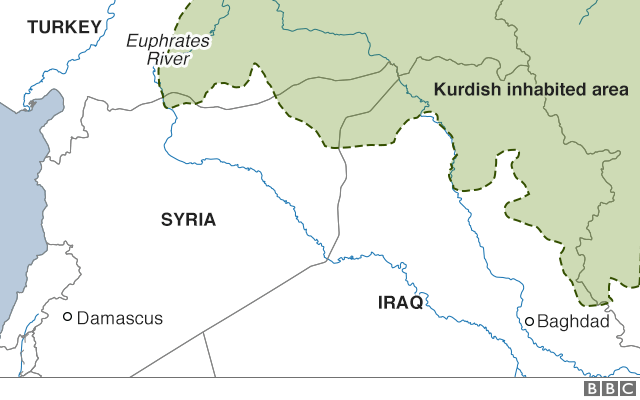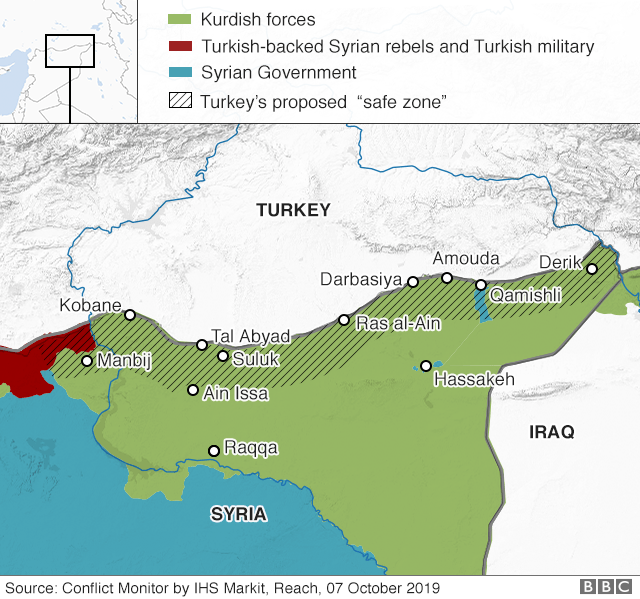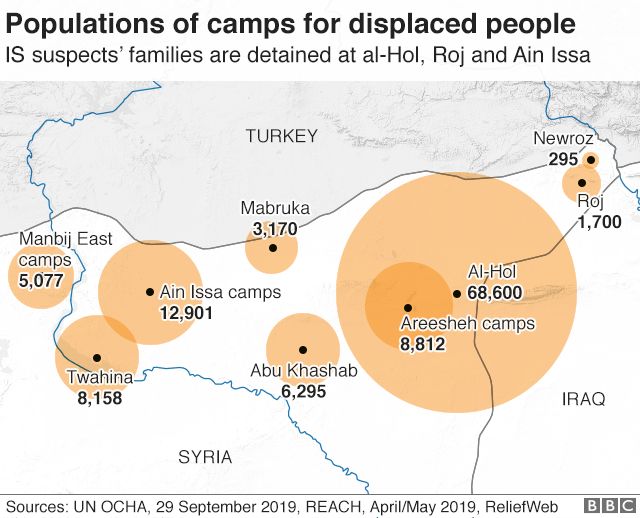Turkey has launched a military operation against Kurdish-led forces in north-eastern Syria, days after US troops pulled back from the border.
These maps help explain the offensive and its potential consequences.
Majority-Kurdish areas

Kurds make up between 7% and 10% of Syria’s population. For decades, they were suppressed and denied basic rights by President Bashar al-Assad and, before him, his father Hafez.
Before the uprising against Mr Assad began in 2011 most Kurds lived in the cities of Damascus and Aleppo, and in three northern areas near the Turkish border – Afrin in the west, Kobane (Ain al-Arab) in the centre, and Qamishli in the east.
When the uprising evolved into a civil war, the main Kurdish parties avoided taking sides. In 2012, government forces withdrew from Kurdish areas to concentrate on fighting rebel factions elsewhere, and Kurdish militias took control in their wake.

In late 2014, the jihadist group Islamic State (IS) launched an assault on Kobane. The battle sparked alarm across the world and a US-led multinational coalition against IS intervened by carrying out air strikes. After the militants retreated, the Kurds became the coalition’s most critical partner on the ground in Syria.
The biggest Kurdish militia, the People’s Protection Units (YPG), formed an alliance with local Arab militias called the Syrian Democratic Forces (SDF) in 2015. With the help of coalition airpower, weaponry and advisers, SDF fighters drove IS out of a quarter of Syria and captured its last pocket of territory in the country in March 2019. They also set up an “autonomous administration” to govern the region.
Turkey’s “safe zone”

Turkey has long threatened to launch a military operation in SDF-held territory to create a 32km (20-mile) deep “safe zone” running for 480km (300 miles) along the Syrian side of the border.
It wants to push back members of the YPG, which it views as an extension of a Kurdish rebel group that has been fighting in Turkey for decades and is designated a terrorist organisation. Turkey also hopes to resettle at least 1 million of the 3.6 million Syrian refugees it is currently hosting in the zone.
In an attempt to avert an offensive, the US military agreed in August to set up with the Turkish military a “security mechanism” in the border area. The YPG co-operated, withdrawing heavy weapons and dismantling fortifications.

The SDF reacted angrily to Mr Trump’s decision, warning that an “unprovoked attack” by Turkey would “have a negative impact on our fight against [IS] and the stability and peace we have created in the region”.
“We are determined to defend our land at all costs,” it added.
It is thought that the Turkish operation will focus initially on a 100km stretch of the border between the towns of Tal Abyad and Ras al-Ain, which is a sparsely populated, mostly Arab area.
Potential population displacement

The area falling within Turkey’s “safe zone” is fertile plain that once served as Syria’s breadbasket. It is dotted with dozens of villages and towns, unlike the barren, desert regions to the south. The city of Qamishli, part of which remains under Syrian government control, had a population of 200,000 before the war.
The International Rescue Committee, a humanitarian organisation, said the region currently under SDF control was home to about 2 million civilians who had “already survived [IS] brutality and multiple displacements”.
“A military offensive could immediately displace at least 300,000 people and disrupt life-saving humanitarian services,” it tweeted on 7 October.

Save the Children said 1.65 million civilians were in need of humanitarian assistance in the region, including more than 650,000 displaced by war.
The UN’s Regional Co-ordinator for Syria, Panos Moumtzis, said it had made contingency plans to assist civilians forced to flee their homes by an offensive.
Any military operation had to take the effects on civilians into account, he warned, adding: “We are hoping for the best, but preparing for the worst”.
Mr Moumtzis said the UN had a “bitter history” with the concept of safe zones and that it never encouraged their creation, citing the massacre at Srebrenica in 1995.
Detained IS fighters and their families

The SDF says that it is detaining more than 12,000 men suspected of being IS members in seven prisons. At least 4,000 of the prisoners are foreign nationals. Some of the prisons are reportedly close to the Turkish border.
The families of suspected IS members meanwhile are being held at three camps for displaced people – Roj, Ain Issa, and al-Hol.
Roj and Ain Issa, which are home to 1,700 and 12,900 people respectively in May 2019, would both be located inside Turkey’s proposed “safe zone”.

Mr Trump told Mr Erdogan that Turkish troops would be responsible for securing detained IS fighters in areas they captured, according to the White House. The SDF has said its fighters will continue to guard the prisons and camps, but there is a concern they could be called away to other areas or be forced to flee if attacked.
Credit: Source Link